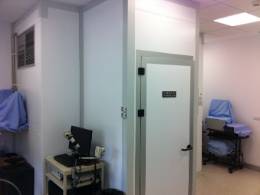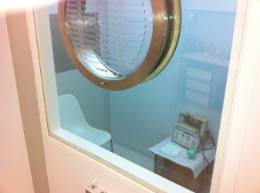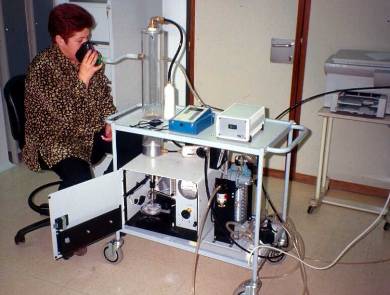Allergology
RESPIRATORY OCCUPATIONAL DISEASES UNIT
Our Respiratory Occupational Allergy Unit is the only facility in Spain equipped with diagnostic capabilities for all types of asthma, respiratory occupational pneumonitis, and environmental studies.
We also study the inflammatory process in occupational asthma caused by substances of both high and low molecular weight, using induced sputum and exhaled nitric oxide to analyse various cell types and inflammatory mediators. We also have experience in measuring occupational allergens both during provocation tests and in the workplace. Our experience is summarised in numerous international publications, along with our participation in drawing up national and international diagnostic guidelines.
 |
 |
View of the dynamic chamber for inhalation provocation tests
The Allergy Service has optimal facilities and equipment to study respiratory pathology of occupational origin caused by both high and low molecular weight substances, represented as follows:
- Experience in using and preparing extracts of different occupational antigens and allergens purified to appropriate concentrations, suitable for testing in immediate hypersensitivity skin tests.
- Desktop and portable spirometers (pneumotachographs) to study respiratory pulmonary function. Our pulmonary function laboratory is complemented by the Pneumology Service's Pulmonary Function and Bronchoscopy laboratory.
- Nebulisers and equipment to study non-specific bronchial hyperreactivity (methacholine test) and for bronchial provocations with water-soluble high molecular weight antigens.
- Portable computerised PEF and VEMS meters, which allow us to measure pulmonary function in our laboratory or in the patient's workplace, with results stored in a microchip to prevent any falsification.
- Ultrasonic nebuliser for sputum induction and experience in handling sputum samples.
- Closed-circuit chamber, the only one in Spain, for exposure to substances in the form of dust (cereal flours, sawdust, antibiotics, etc.), using a laser monitor (dust track) to constantly measure the concentration of particles the patient is exposed to.
- Dynamic provocation chamber –also unique in Spain– to generate and maintain stable concentrations of certain low molecular weight substances, e.g. isocyanates, aldehydes (glutaraldehyde, formaldehyde) or other substances. In the case of isocyanates (TDI, MDI, HDI) and other compounds, a special monitor can be used to measure the concentration of these substances inside the chamber in real time, preventing the levels considered irritating or toxic from being exceeded. The chamber has an antechamber, a ventilation system and interlocking doors to prevent the substances under study from escaping into the laboratory.
- Environmental studies: we have high- and low-flow samplers and low-flow personal pumps to measure allergen concentrations in ambient air using immunological techniques.
- Possibility of on-site studies. Patients can be studied on an outpatient or inpatient basis. A preliminary estimate or an agreed price is provided, in line with the type of study to be carried out.

Closed-circuit chamber for dust inhalation
BRONCHIAL HYPERRESPONSIVENESS AND ASTHMA IN SPORTS UNIT
Our service uses all the techniques endorsed by the International Olympic Committee for studying asthma in athletes (methacholine and mannitol provocation tests, eucapnic hyperventilation). We are a referral centre for many sports Federations and the Spanish Olympic Committee.
SEVERE ASTHMA UNIT
We are part of the multidisciplinary severe asthma unit, which also includes specialists in pulmonology, ENT and immunology. This unit is accredited with a level of excellence by the Pneumology (SEPAR) and Allergology (SEAIC) Societies. Here, patients with severe asthma are studied and biological medications are administered. Thermoplasty is also administered.
Hospital Universitario Fundación Jiménez Díaz
Avda. Reyes Católicos, 2
28040 Madrid Madrid
© 2025 Quirónsalud - All rights reserved























